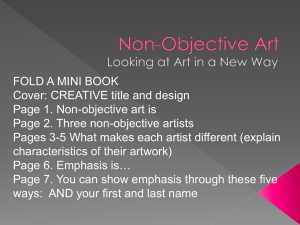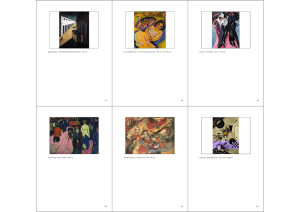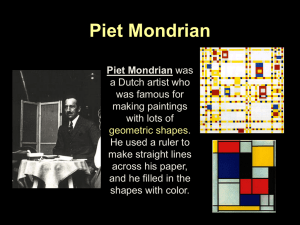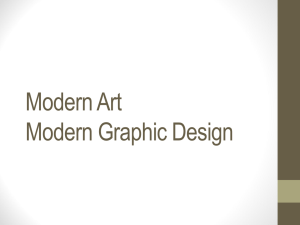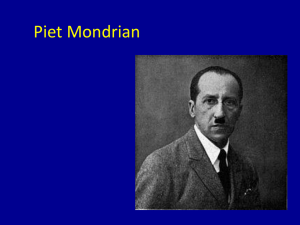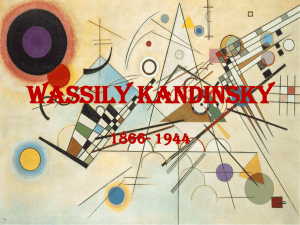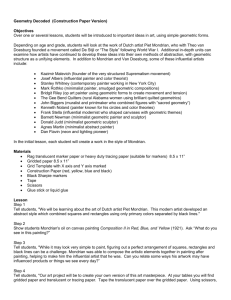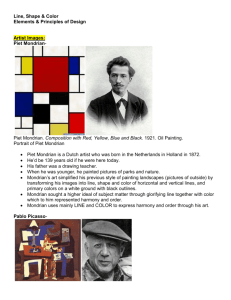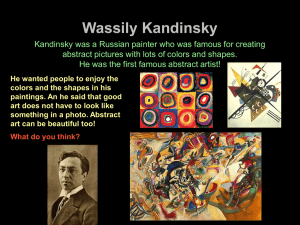How Non-objective art began
advertisement
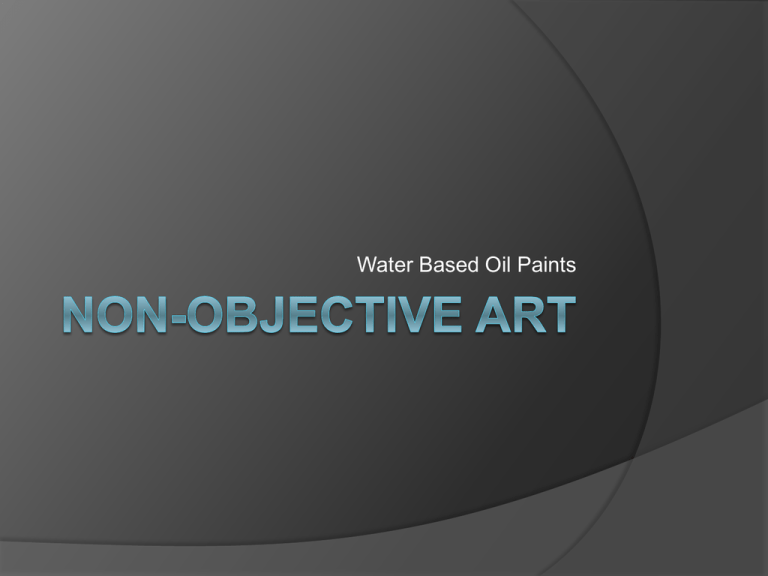
Water Based Oil Paints What is Non-objective Art? Visual art that does not represent a subject Not a picture of something Colors and forms compose the image The subject of non-objective art may be: - the process - the color - the pigment itself How Non-objective art began Modern period was in search of the new It was thought that anything beyond materials and the mind of the maker were irrelevant Subjective, expressive Led to the dismantling of subject matter Need for representation diminished Wassily Kandinsky Composition VII," 1913 • Considered the first Non-objective artist • An accomplished musician “Color is the keyboard, the eyes are the harmonies, the soul is the piano with many strings. The artist is the hand that plays, touching one key or another, to cause vibrations in the soul.” • • The concept that color and musical harmony are linked Q: What do you see? How does this painting make you feel? Q: What type of music do you think Kandinsky was listening to when he created this painting? Wassily Kandinsky Composition VI," 1911 Kandinsky used color in a highly theoretical way: • tone with timbre (the sound's character) • hue with pitch • saturation with the volume of sound He even claimed that when he saw color he heard music De Stijl Dutch for "The Style", also known as neoplasticism Body of work from 1917 to 1931 founded in the Netherlands Neoplasticism — the new plastic art Group included painters and architects Elements of De Stijl Wanted to express a new utopian ideal of spiritual harmony and order They advocated pure abstraction and universality Reduce to the essentials of: -form and color - visual compositions of vertical and horizontal direction - used only primary colors, black and white Piet Mondrian Piet Mondrian (1872-1944) was a Dutch Abstract painter of the first half of the 20th Century. Disciple of the famous cubists Pablo Picasso and Georges Braque Challenged the definition of art itself Simple lines, right angles, correct geometric figures and pure, primary colors Theo van Doesburg Discovered Piet Mondrian’s work, which convinced van Doesburg to paint geometric abstractions of subjects from nature Architecture The De Stijl influence on architecture remained considerable long after 1931 Between 1923 and 1924, Rietveld designed the Rietveld Schröder House, Only building to have been created completely according to De Stijl principles. Color Field Painters Concentrated largely on: - relationships between elements of color - nature of the surface: its size, shape and texture Artists were interested in the lyrical or atmospheric effects of vast expanses of color Color filled the canvas, and by suggestion, beyond it to infinity. Most color-field paintings are large — meant to be seen up close so that the viewer is immersed in a color environment. Mark Rothko Solid areas of color covering the entire canvas "...abstract art does not employ subject matter that is obvious as either the anecdote or familiar objects, yet it must appeal to our experience in some way. Instead of appealing to our sense of the familiar, it simply functions in another category." - Color-field Artist Mark Rothko, in his book The Artist's Reality: Philosophies of Art, p80. Minimalists Minimalism is an attempt to boil art and creativity down to the most basic level. Explores the simplest modes of expression: color and shape Artists may not need the steadiest hand to paint in the minimalism style, but creative vision is required. The kind of art based on an idea rather than on an object is called conceptual art Exposed Painting: Cadmium Orange on White, 1997 Callum Innes 1980s Minimalist treatment of surface through the application of monochrome layers of paint As the title suggests, the working process is completely 'exposed‘ A broad band of orange paint has been laid across the pristine white surface, and then a section of the band, while still wet, has been washed downwards Master Works Here are a few works of art you will recognize 1 2 3 Hmmm, let’s look at these again Now do you recognize it? 1 How about this one? 2 Last but not least 3 Cropping Cropping refers to removing unwanted areas from an image Power of cropping View finder Assignment Time
